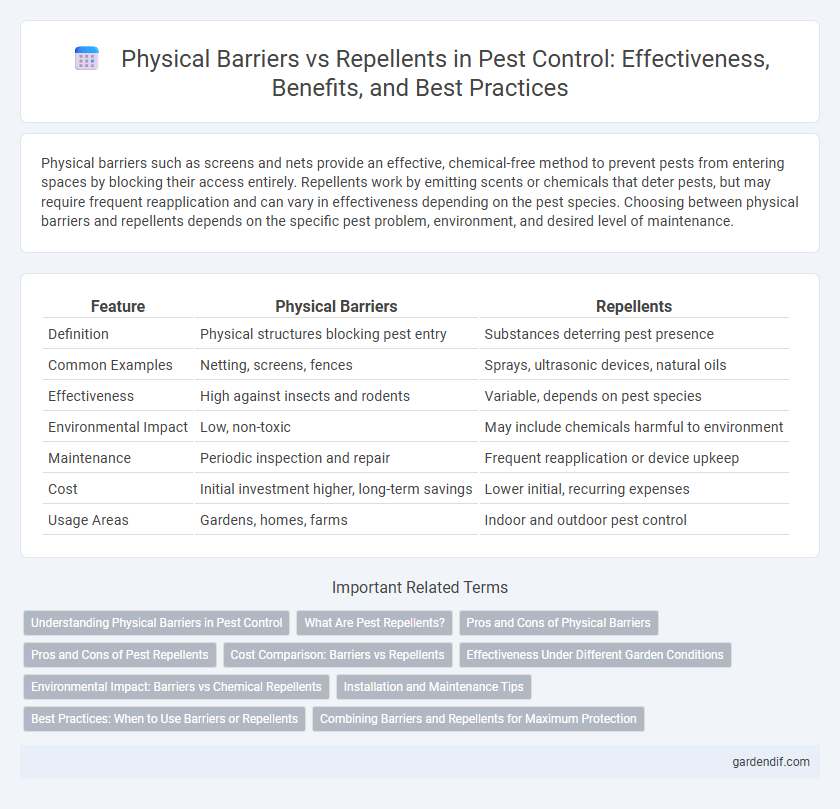
Physical barriers vs Repellents Illustration
Physical barriers such as screens and nets provide an effective, chemical-free method to prevent pests from entering spaces by blocking their access entirely. Repellents work by emitting scents or chemicals that deter pests, but may require frequent reapplication and can vary in effectiveness depending on the pest species. Choosing between physical barriers and repellents depends on the specific pest problem, environment, and desired level of maintenance.
Table of Comparison
| Feature | Physical Barriers | Repellents |
|---|---|---|
| Definition | Physical structures blocking pest entry | Substances deterring pest presence |
| Common Examples | Netting, screens, fences | Sprays, ultrasonic devices, natural oils |
| Effectiveness | High against insects and rodents | Variable, depends on pest species |
| Environmental Impact | Low, non-toxic | May include chemicals harmful to environment |
| Maintenance | Periodic inspection and repair | Frequent reapplication or device upkeep |
| Cost | Initial investment higher, long-term savings | Lower initial, recurring expenses |
| Usage Areas | Gardens, homes, farms | Indoor and outdoor pest control |
Understanding Physical Barriers in Pest Control
Physical barriers in pest control create an impenetrable shield that prevents insects, rodents, and other pests from accessing crops, homes, or stored goods, significantly reducing infestation risks. Materials such as mesh screens, row covers, and sealed entry points provide effective defense by blocking pest entry without relying on chemicals. Unlike repellents, which deter pests through odors or tastes that require frequent reapplication, physical barriers offer a sustainable, long-lasting pest management solution by eliminating the opportunity for pests to reach protected areas.
What Are Pest Repellents?
Pest repellents are substances or devices designed to deter pests such as insects, rodents, and other animals from infesting or damaging areas without necessarily killing them. These repellents work by emitting odors, sounds, or chemical compounds that pests find unpleasant or disorienting, effectively keeping them away from homes, gardens, or storage spaces. Unlike physical barriers that block pest entry, repellents provide a non-lethal, preventive approach to pest control by modifying pest behavior and reducing their presence.
Pros and Cons of Physical Barriers
Physical barriers effectively prevent pest entry by creating a solid obstruction, reducing the need for chemical use and minimizing environmental impact. However, they can be costly to install and maintain, may not cover all pest entry points, and can be less effective against small or flying insects. Their durability and reusability make them a sustainable option, but adaptability to different pest species and environments can be limited.
Pros and Cons of Pest Repellents
Pest repellents offer a chemical or natural solution to deter pests without causing physical obstruction, making them easy to apply across various surfaces and environments. However, their effectiveness can be inconsistent, often requiring frequent reapplication and potentially losing efficacy due to weather conditions or pest adaptation. While repellents reduce the risk of physical damage associated with barriers, some may pose health risks or environmental concerns depending on their chemical composition.
Cost Comparison: Barriers vs Repellents
Physical barriers such as mesh screens and fencing generally involve higher upfront costs but offer long-term durability and require minimal maintenance expenses. Repellents, including chemical sprays and ultrasonic devices, often incur lower initial costs but demand frequent reapplication or replacement, leading to recurring expenses. Evaluating cost-effectiveness depends on pest type, area coverage, and maintenance capabilities, with barriers proving more economical for sustained pest exclusion.
Effectiveness Under Different Garden Conditions
Physical barriers provide consistent protection against pests by creating an impenetrable shield, especially effective in gardens with high moisture or dense foliage where repellents may wash away or degrade quickly. Repellents rely on chemical or natural deterrents that vary in effectiveness depending on environmental factors such as rainfall, temperature, and pest species diversity. Combining physical barriers with targeted repellent use enhances overall pest control by addressing limitations posed by variable garden conditions.
Environmental Impact: Barriers vs Chemical Repellents
Physical barriers provide an eco-friendly solution by preventing pest access without introducing harmful chemicals into the environment, preserving soil and water quality. Chemical repellents, while effective in deterring pests, often contain substances that can accumulate and disrupt ecosystems, impacting beneficial insects and pollinators. Sustainable pest management prioritizes physical barriers to minimize environmental impact and promote biodiversity.
Installation and Maintenance Tips
Physical barriers such as screens, nets, and door seals require precise installation to ensure no gaps exist for pests to enter; regular inspection and timely repairs are crucial for maintaining their effectiveness. Repellents, including chemical sprays and ultrasonic devices, should be applied according to manufacturer guidelines, with periodic reapplication or battery replacement to sustain their protective function. Combining barrier integrity checks with scheduled repellent treatments enhances long-term pest control efficacy.
Best Practices: When to Use Barriers or Repellents
Physical barriers are most effective when preventing pests from accessing plants or areas, especially in gardens and greenhouses, where they create a direct obstruction to insects and rodents. Repellents work best in open environments or on larger scales where pests can be deterred without physical contact, utilizing chemical or natural substances to create an unpleasant environment. Best practice involves using barriers during early pest infestation stages for containment and repellents for ongoing management or when barriers are impractical.
Combining Barriers and Repellents for Maximum Protection
Combining physical barriers such as screens, nets, and row covers with chemical or natural repellents significantly enhances pest protection by preventing entry and deterring feeding simultaneously. Physical barriers create an impenetrable layer to block pests like aphids, beetles, and caterpillars, while repellents confuse or repel pests through scents or tastes they avoid. Integrated use of barriers and repellents reduces reliance on pesticides, promoting sustainable pest management and minimizing crop damage.
Physical barriers vs Repellents Infographic

 gardendif.com
gardendif.com